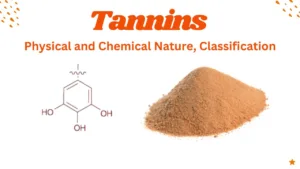Tannins
Physical and Chemical Nature, Classification

Tannins
Tannins are natural polyphenolic compounds with astringent properties. They are widely distributed in various plant parts and contribute to the bitter taste in foods like tea and certain fruits. Tannins are characterized by their ability to bind to proteins and other organic compounds, making them essential for several practical applications.
• Coined by Seguin in 1796
• Tannins are polyhydroxy phenolic – o- dihydroxy or o-trihydroxygroups on phenyl ring
• High molecular weight compounds – non nitrogenous compounds
• Astringent Property – combine with protein – ppt them – used in medicien to treat burn, wounds, diarrhoea
• React with protein of animal hide, prevent their putrefaction and convert hide and skin into leather (Astringent)
• Present in solution form in the cell sap and also in distinct vacuoles
Occurrence in Nature
Tannins are prevalent in nature, found in various plant-based sources. They are abundant in fruits such as grapes, pomegranates, and berries. Bark and wood from trees like oak and chestnut also contain high concentrations of tannins, which serve as a defense mechanism against herbivores and pathogens.
Physical properties of Tannins
State: Non-crystalline
• Form colloidal solutions with water
Solubility: Soluble in water, alcohol, dilute alkalis, glycerol and acetone
Insoluble – organic solvents except acetone
Chemical properties of Tannins
• Tannins have ability to precipitate the solutions of
– Gelatin,
– Alkaloids
– Glycosides
– Heavy metals
– Proteins
• They are precipitated by chromic acid or potassium dichromate and salts of copper, tin and lead
• Colour reactions with iron salts – Ferric chloride – blusih black colour or green colour
• Tannins with potassium ferricyanide and ammonia gives deep red colour
Uses of Tannins
• Astringent property – Healing of wounds, inflammed mucosa, antidiarrhoeal, anti haemmorhagic, antiseptic
• Treatment of varicose ulcers, minor burns, inflammation of gums
• Leather industry – converting hide into leather and also acts as preservative
• Manufacture of inks – with iron salts form deep colours
• Sizing paper, mordant in dyeing, printing fabrics and silk
• Along with gelatin and albumin – manufacture of artificial horns, tortoise shells
• Laboratory reagents – to identify gelatin, proteins and alkaloids – because it precipitates them
• Antidote for heavy metal poisoning – it forms insoluble alk.tannates
Classification of Tannins
There are two main categories of tannins: hydrolyzable and non-hydrolyzable (condensed) tannins. Hydrolyzable tannins are found in fruits and are composed of glucose molecules. On the other hand, non-hydrolyzable tannins, also known as condensed tannins, are polymerized flavonoids and are commonly found in plants like trees and shrubs.
• Based on their complex chemical nature and their behavior towards dry distillation
• Hydrolysable tannins
• Condensed tannins
• Pseudo tannins
Hydrolysable Tannins
• Hydrolyzed by enzymes or acids – Gallic acid or ellagic acid Hydrolysable tannins – Dry distillation à Pyrogallols + Phenolic compounds
Hydrolysable tannins + iron salts à Blue colour
Gallotannin – Nutgall, clove, rhubarb
Ellagitannin – Oak, Myrobalan
Condensed Tannins/Non Hydrolysable Tannins
• Non hydrolysable – Resist hydrolysis
• Undergo polymerisation – insoluble red compounds phlobaphens (red colour – cinchona and rhubarb)
• Condensable tannins – Dry distillation à Catechol
• Condensable tannins + iron salts à Brownish Green colour
Examples:
Pale Catechu, Asoka bark, Hamamelis, Cinchona, Cinnamon
Pseudo Tannins
Low molecular weight, do not obey Gold Beaters skin Test
Examples:
Chlorogenic aid – Nuxvomica seed
Ipecacuanhic acid – Ipecac
Health Benefits of Tannins
Tannins possess antioxidant properties that help protect cells from oxidative stress. They have been linked to potential cardiovascular benefits, such as improving heart health and reducing the risk of certain diseases. However, more research is needed to fully understand their effects on human health.
Tannins in Traditional Medicine
Throughout history, tannin-rich plants have been used in traditional medicine for their healing properties. Tannins have been applied topically to treat skin conditions and used internally for their potential anti-diarrheal and anti-inflammatory effects.
Potential Side Effects
While tannins offer health benefits, excessive consumption can interfere with mineral absorption and lead to digestive discomfort. It’s important to maintain a balanced intake and be mindful of dietary sources rich in tannins.
Summary
• Poly hydroxy phenolic non nitrogenous, astringent
• Precipitate gelatin, alkaloids, glycosides, heavy metals and proteins
• Based on identity of phenolic nuclei – Hydrolysable, condensed and complex tannins
• Hydrolysable tannins on dry distillation gives pyrogallols
• Condensed tannins on dry distillation gives catechol
• Complex tannins are biosynthesized from mixtures of both, hydrolysable and condensed tannins
• Based on tanning test – True and pseudo tannins
FAQs (Frequently Asked Questions)
- Are tannins only found in plants? Tannins are primarily found in plants, but they can also be present in certain foods and beverages derived from these plants.
- Do tannins contribute to the aging of wine? Yes, tannins play a significant role in the aging process of red wines, contributing to their texture and flavor development.
- Can tannins be harmful to health? While tannins offer health benefits, excessive consumption can have adverse effects, particularly on mineral absorption and digestion.
- Are there tannins in coffee? Yes, coffee beans contain tannins, which can contribute to the slightly bitter taste of coffee.
- How are tannins extracted for industrial use? Tannins are extracted through various methods, including maceration and solvent extraction, depending on the source material and intended application.
Also, Visit: Biotechnology Notes

